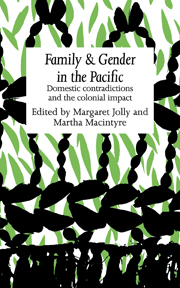Book contents
- Frontmatter
- Contents
- List of contributors
- Acknowledgements
- Map of main island groups of the Pacific
- Map of Papua New Guinea – Provinces
- Introduction
- 1 New England missionary wives, Hawaiian women and ‘The Cult of True Womanhood’
- 2 Changes in the lives of ordinary women in early post-contact Hawaii
- 3 Domestic structures and polyandry in the Marquesas Islands
- 4 The object lesson of a civilised, Christian home
- 5 Medical care and gender in Papua New Guinea
- 6 Suffer the children: Wesleyans in the D'Entrecasteaux
- 7 Women in contemporary Central Enga society, Papua New Guinea
- 8 Better homes and gardens
- 9 God, ghosts and people: Christianity and social organisation among Takuru Wiru
- 10 Sins of a mission: Christian life as Kwaio traditionalist ideology
- 11 Sacred spaces: churches, men's houses and households in South Pentecost, Vanuatu
- 12 Bond-slaves of Satan: Aboriginal women and the missionary dilemma
- Bibliography
- Index
8 - Better homes and gardens
Published online by Cambridge University Press: 05 November 2011
- Frontmatter
- Contents
- List of contributors
- Acknowledgements
- Map of main island groups of the Pacific
- Map of Papua New Guinea – Provinces
- Introduction
- 1 New England missionary wives, Hawaiian women and ‘The Cult of True Womanhood’
- 2 Changes in the lives of ordinary women in early post-contact Hawaii
- 3 Domestic structures and polyandry in the Marquesas Islands
- 4 The object lesson of a civilised, Christian home
- 5 Medical care and gender in Papua New Guinea
- 6 Suffer the children: Wesleyans in the D'Entrecasteaux
- 7 Women in contemporary Central Enga society, Papua New Guinea
- 8 Better homes and gardens
- 9 God, ghosts and people: Christianity and social organisation among Takuru Wiru
- 10 Sins of a mission: Christian life as Kwaio traditionalist ideology
- 11 Sacred spaces: churches, men's houses and households in South Pentecost, Vanuatu
- 12 Bond-slaves of Satan: Aboriginal women and the missionary dilemma
- Bibliography
- Index
Summary
Today on Tubetube people live in small, two-roomed houses built on piles a metre or so from the ground. The wood for beams, posts and joists comes from neighbouring islands, for Tubetube is small and prone to drought. Few hardwood trees grow there and there is very little swampy land where sago palms might flourish. Before a house is built Tubetube people enter into exchange agreements promising clay pots, areca nuts and occasionally cash for hardwood trunks and sago spathes. The only home-grown materials are the vines for lashing and areca palm trunks that are split to make slats for the floors. These houses, being made entirely from ‘bush materials’, conform to Western notions of the primitive or traditional architecture appropriate to a small tropical island.
Most Tubetube people are aware that these houses are quite different from those that their ancestors built and can describe the various innovations in style. They attribute these changes entirely to the Samoans, Fijians and Tongans who came as teachers with the Wesleyan mission a century ago. According to legend, these men not only destroyed their old clan houses but insisted that they rebuild in what is now called ‘Fijian style’. My own research suggests that the Polynesian mission teachers were not the only agents of change but that they were the first and most consistent destroyers of houses in which relics of the dead were stored.
I became intrigued by the demise of Tubetube architecture and the consequences or ramifications of the decline before I went to Tubetube.
- Type
- Chapter
- Information
- Family and Gender in the PacificDomestic Contradictions and the Colonial Impact, pp. 156 - 169Publisher: Cambridge University PressPrint publication year: 1989
- 7
- Cited by



